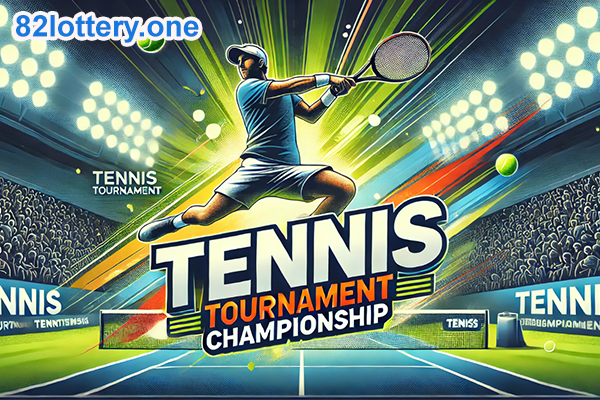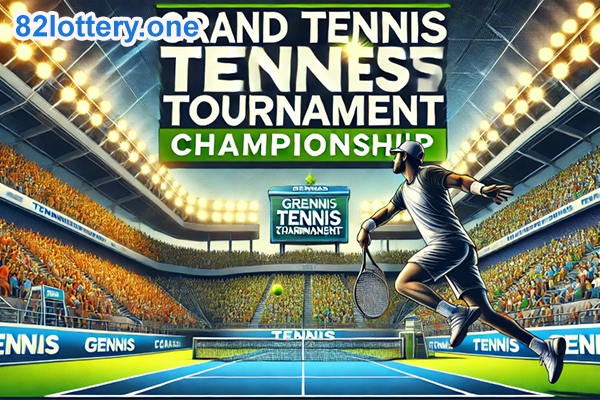Tennis tournament is more than just a competition. it’s a battle of endurance, strategy, and skill. Whether you’re a passionate player or a dedicated fan, understanding the structure, significance, and history of these events can deepen your appreciation for the sport. let’s dive into this Sport 82 lottery to know more
What Is a Tennis Tournament?
tennis tournament is an organized competition where players compete for titles, ranking points, and prize money. These tournaments vary in level, from amateur club competitions to prestigious global championships like Grand Slams, ATP, and WTA events.

read more
Types of Tennis Tournaments
The Grand Slam tournaments are the four most prestigious and widely watched tennis events in the world. They offer the highest ranking points, substantial prize money, and historic venues that have witnessed some of the greatest moments in tennis history. These tournaments are played annually and represent the ultimate goal for professional players.
Australian Open
Surface: Hard court (GreenSet)
Location: Melbourne, Australia
Time: January (Summer in Australia)
Venue: Melbourne Park
Notable Record Holders:
- Men’s Singles: Novak Djokovic (10 titles)
- Women’s Singles: Margaret Court (11 titles)
Key Features of the Australian Open
Known as the “Happy Slam” due to its lively atmosphere.
First Grand Slam of the year, setting the tone for the season.
Played on GreenSet hard courts, which are medium-paced with high bounce.
Matches are often affected by extreme heat, leading to the introduction of a heat policy with roof closures on main courts.
Features late-night matches that sometimes extend past midnight due to the scheduling of multiple matches per day.
Memorable Moments
2012 Final: Novak Djokovic defeated Rafael Nadal in a 5-hour, 53-minute epic—the longest Grand Slam final ever.
2003: Serena Williams completed her first “Serena Slam” by winning her fourth consecutive major.
French Open (Roland Garros)
Surface: Clay court
Location: Paris, France
Time: May–June
Venue: Stade Roland Garros
Notable Record Holders:
- Men’s Singles: Rafael Nadal (14 titles – “The King of Clay”)
- Women’s Singles: Chris Evert (7 titles)
Key Features of the French Open
The only Grand Slam played on clay, which is the slowest surface, leading to longer rallies and physically demanding matches.
Known for producing some of the most grueling and tactical battles in tennis history.
Matches can last over four to five hours due to the high bounce and difficulty in hitting winners.
Uses best-of-five format for men and best-of-three for women without a final-set tiebreak (until 2022).
Night sessions were introduced in 2021, allowing for prime-time broadcasting.
Memorable Moments
2008 Final: Rafael Nadal crushed Roger Federer 6–1, 6–3, 6–0, marking one of the most dominant Grand Slam final performances.
1989: 17-year-old Michael Chang won the title, famously serving underhand against Ivan Lendl in the fourth round due to severe cramping.
Wimbledon
Surface: Grass court
Location: London, United Kingdom
Time: June–July
Venue: All England Club
Notable Record Holders:
- Men’s Singles: Roger Federer (8 titles)
- Women’s Singles: Martina Navratilova (9 titles)
Key Features of Wimbledon
The oldest and most prestigious tennis tournament, established in 1877.
The only Grand Slam played on grass courts, making for fast-paced, low-bouncing matches that favor serve-and-volley players.
Players must adhere to a strict all-white dress code.
Features royal family appearances, including the Duke and Duchess of Cambridge.
The only Grand Slam that was canceled in 2020 due to COVID-19.
Memorable Moments
2019 Final: Novak Djokovic saved two championship points to defeat Roger Federer in a historic final-set tiebreak at 13–12.
2008 Final: Rafael Nadal defeated Roger Federer in what is often called the “greatest match ever”, lasting 4 hours, 48 minutes, ending in near darkness.
2010: John Isner and Nicolas Mahut played the longest match in tennis history, lasting 11 hours, 5 minutes, with a final-set score of 70–68.

US Open
Surface: Hard court (Acrylic DecoTurf)
Location: New York, USA
Time: August–September
Venue: USTA Billie Jean King National Tennis Center
Notable Record Holders:
- Men’s Singles: Jimmy Connors, Pete Sampras, and Roger Federer (5 titles each in the Open Era)
- Women’s Singles: Serena Williams and Chris Evert (6 titles each in the Open Era)
Key Features of the US Open
The final Grand Slam of the year.
The first Grand Slam to use a final-set tiebreak (introduced in 1970).
Played on DecoTurf, a hard surface that is faster than the Australian Open courts.
Known for its electric New York atmosphere, with rowdy crowds and night sessions.
Arthur Ashe Stadium is the largest tennis stadium in the world, seating over 23,000 fans.
Memorable Moments
2012 Final: Andy Murray won his first Grand Slam title, defeating Novak Djokovic in a five-set battle lasting nearly five hours.
1991: Jimmy Connors, at 39 years old, made an epic run to the semifinals, capturing the hearts of tennis fans.
2001: Serena Williams vs. Venus Williams made history as the first all-sister Grand Slam final in the Open Era.
Why Are Grand Slam Tournaments Special?
Biggest Prize Money & Ranking Points: Winners receive 2,000 ATP/WTA points and millions in prize money.
Historic Venues: These tournaments are played in the most iconic tennis arenas.
Elite Competition: Only the best players in the world participate.
Unique Playing Conditions: Each tournament has different court speeds, ball bounces, and weather conditions.
The Grand Slam tournaments are the pinnacle of tennis, producing legendary moments that shape the sport’s history. Winning even one Grand Slam is a remarkable achievement, and players who dominate these events cement their legacies among the all-time greats.
siasts. Let me know if you’d like more details or refinements! 🎾🔥
ATP & WTA Tournaments
These professional-level tournaments are categorized based on ranking points and prize money:
ATP (Men’s Tour) & WTA (Women’s Tour) Tiers
ATP/WTA 1000 – Premier tournaments just below the Grand Slams
ATP/WTA 500 – Mid-level professional tournaments
ATP/WTA 250 – Entry-level professional tournaments
These events contribute significantly to a player’s ranking and career progression.
Challenger & ITF Tournaments
ATP Challenger Tour & WTA 125 – Secondary-level professional tournaments where players gain experience and ranking points to enter ATP/WTA events.
ITF World Tennis Tour – Lower-tier competitions that help young and upcoming players transition to professional tennis.
Davis Cup & Billie Jean King Cup
These are international team tournaments where countries compete against each other:
Davis Cup – The Men’s World Cup of Tennis.
Billie Jean King Cup – The Women’s World Cup of Tennis.
Junior & Amateur Tournaments
ITF Junior Circuit – For young players under 18 aiming to go pro.
College Tennis Tournaments – NCAA events help student-athletes build careers.
Club & Local Tournaments – Held at various levels for amateur players.
How Do Tennis Tournaments Work?
Tournament Formats
Tournaments typically follow these structures:
Single-Elimination: Players are eliminated after one loss. (Used in Grand Slams and ATP/WTA tournaments)
Round-Robin: Players compete in groups before moving to knockout rounds. (Used in ATP Finals and team tournaments)
Qualifying Rounds: Lower-ranked players compete for a spot in the main draw.
Match Rules and Scoring System
Best-of-Three Sets: Used in most tournaments. The first player to win two sets wins the match.
Best-of-Five Sets: Used in men’s Grand Slam matches, requiring three set wins to claim victory.
Tiebreaks: Used to decide sets that reach 6-6 (except in the final set of some Grand Slams).
Ranking System & Prize Money
Players earn ATP & WTA ranking points based on performance in tournaments. Higher-ranked tournaments offer more points, helping players move up in the global rankings.
For example, Grand Slam winners earn 2,000 points, while ATP/WTA 1000 winners receive 1,000 points.
Prize money also varies based on the tournament’s prestige. Grand Slam winners can earn millions of dollars, while lower-tier events offer smaller payouts.
Famous Tennis Tournaments & Records
Most Grand Slam Titles (Singles)
Men: Novak Djokovic (24 Grand Slam titles)
Women: Margaret Court (24 Grand Slam titles), Serena Williams (23)
Most Wimbledon Titles
Men: Roger Federer (8 titles)
Women: Martina Navratilova (9 titles)
Longest Tennis Match
John Isner vs. Nicolas Mahut (2010 Wimbledon) – 11 hours, 5 minutes
Tips for Watching & Attending a Tennis Tournament
Want to make the most of a tennis tournament experience? Here are some tips:
Get Your Tickets Early – Major tournaments sell out quickly.
Follow the Schedule – Matches can last hours, so plan accordingly.
Check the Weather – Outdoor events can be delayed due to rain.
Learn About the Players – Knowing player stats makes matches more exciting.
Bring Essentials – Sunscreen, hats, and water bottles are must-haves for outdoor events.
Final Thoughts
A tennis tournament is a thrilling spectacle that showcases the best of the sport. Whether you’re watching the Grand Slams or playing in a local competition, these events offer excitement, drama, and unforgettable moments.
Stay updated on upcoming tournaments, follow your favorite players, and enjoy the electrifying atmosphere of professional tennis!